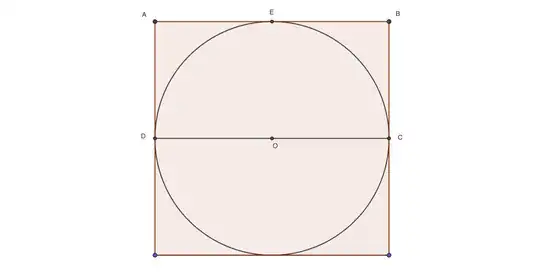There are a few steps in a constructive proof that $\pi \neq 4$ that I cannot fully justify. Here is a sketch of the proof, with the step I don't fully understand bolded.
Inscribe a circle of radius $1$ inside a square of side length $2$. The area of the circle is $\pi$ and the area of the outer square is $4$. Call the center of the circle $O$ and the upper left corner of the square $A$, and draw a line segment $OA$ between $O$ and $A$. Along with the radial length from $O$ to the left side of the square (of unit length), this forms a right triangle with both legs having length $1$. So by the Pythagorean theorem, $|OA| = \sqrt{2}$. Let $C$ be the pint at which $OA$ intersects the circle. Then $|OC| = 1$, the radius of the circle, so $|AC| = \sqrt{2} - 1$. Now, draw a vertical segment from $C$ to the boundary to the square, and call the point where it touches the square $B$; this forms a right angle. Extending a horizontal segment from $C$ to the left edge of the square forms a quadrilateral $ABCD$. This quadrilateral is a square with diagonal length $\sqrt{2} - 1 > 0$, so its area is positive but does not contribute to the area of the circle. This means that the combined area of the circle with center $O$ and the square $ABCD$ is less than or equal to the area of the square which is $4$. Let $c$ denote the area of $ABCD$. Then $\pi + c \leq 4$, so $\pi \leq 4 - c < 4$.
I'm not fully sure if my language is sufficiently precise. I'm trying to justify that I'm actually forming a square and that these angles are in fact right angles. In order to show that, I believe I can show one of a few possible facts: that all the angles are right angles or that the diagonals are perpendicular. The figure itself is a square, so $\langle A$ is $90$ degrees. I tried to justify drawing segments from $C$ upward to the square and to the left of $C$ gives a right angle, so that would give $\langle C = 90$ degrees. I don't know how to justify, other than by looking at the picture, that $\langle B$ and $\langle D$ are $90$ degrees. Despite all of this, I think I don't need the figure to be a square (even though it surely is): the fact that it has a diagonal of positive length is enough to say that it contributes positive area.
